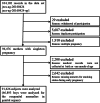Association between maternal smoking history and congenital anomalies in children: Results from the Japan Environment and Children's Study
- PMID: 34041797
- PMCID: PMC8453515
- DOI: 10.1111/cga.12430
Association between maternal smoking history and congenital anomalies in children: Results from the Japan Environment and Children's Study
Abstract
We investigated the relationship between maternal smoking history and congenital anomalies in children. Drawing on data from the Japan Environment and Children's Study collected between January 2011 and March 2014, the smoking habits of pregnant women were categorized as "never smoked," "quit before pregnancy, "quit after pregnancy," and "full smoking." Of the 91 626 participants examined, a total of 2199 (2.4%) infants were born with any congenital anomalies. Logistic regression analysis was used to determine the odds ratio for congenital anomalies in each group based on maternal smoking history. No significant difference was seen between the full-smoking and never smoked groups in the odds ratios for congenital anomalies of the nervous system; the eyes, ears, face, and neck; the cardiovascular system; or the musculoskeletal system. However, in the full-smoking group, the odds ratios for trisomy (adjusted odds ratio, 2.14; 95% confidence interval, 1.15-3.97) and any congenital anomalies (adjusted odds ratio, 1.35; 95% confidence interval, 1.09-1.67) were significantly higher compared with the never smoked group. Our results indicate that continuing to smoke during pregnancy is associated with increased risk of trisomy and any congenital anomalies in the general Japanese population.
Keywords: birth cohort; birth defects; congenital malformation; tobacco smoke; trisomy.
© 2021 The Authors. Congenital Anomalies published by John Wiley & Sons Australia, Ltd on behalf of Japanese Teratology Society.
Conflict of interest statement
The authors declare no conflict of interest.
Figures
Similar articles
-
Maternal Cigarette Smoking and Congenital Upper and Lower Limb Differences: A Systematic Review and Meta-Analysis.J Clin Med. 2023 Jun 21;12(13):4181. doi: 10.3390/jcm12134181. J Clin Med. 2023. PMID: 37445217 Free PMC article. Review.
-
Congenital Anomalies in Infants in Fukushima from 2011 to 2014: The Japan Environment and Children's Study.JMA J. 2023 Jan 16;6(1):36-47. doi: 10.31662/jmaj.2022-0087. Epub 2022 Dec 26. JMA J. 2023. PMID: 36793518 Free PMC article.
-
Maternal cigarette smoking before or during pregnancy increases the risk of birth congenital anomalies: a population-based retrospective cohort study of 12 million mother-infant pairs.BMC Med. 2022 Jan 11;20(1):4. doi: 10.1186/s12916-021-02196-x. BMC Med. 2022. PMID: 35012532 Free PMC article.
-
Active and passive maternal smoking during pregnancy and birth outcomes: the Kyushu Okinawa maternal and child health study.BMC Pregnancy Childbirth. 2013 Aug 6;13:157. doi: 10.1186/1471-2393-13-157. BMC Pregnancy Childbirth. 2013. PMID: 23919433 Free PMC article.
-
[Relationship between congenital heart disease and various factors affecting pregnancy].Orv Hetil. 1992 Jan 19;133(3):155-8. Orv Hetil. 1992. PMID: 1734344 Review. Hungarian.
Cited by
-
Maternal Cigarette Smoking and Congenital Upper and Lower Limb Differences: A Systematic Review and Meta-Analysis.J Clin Med. 2023 Jun 21;12(13):4181. doi: 10.3390/jcm12134181. J Clin Med. 2023. PMID: 37445217 Free PMC article. Review.
References
-
- World Health Organization . Congenital anomalies. Fact Sheet 2020; http://www.who.int/mediacentre/factsheets/fs370/en/. Accessed 5 April 2021.
-
- Dwyer JB, Broide RS, Leslie FM. Nicotine and brain development. Birth Defects Res C Embryo Today. 2008;84(1):30‐44. - PubMed
-
- Norman CA, Halton DM. Is carbon monoxide a workplace teratogen? A review and evaluation of the literature. Ann Occup Hyg. 1990;34(4):335‐347. - PubMed
-
- Eriksen M, Mackay J, Schluger N, Islami F, Drope J. The tobacco atlas. In: 5thAtlanta: the American Cancer Society; 2015. Accessed 10 April 2021.
MeSH terms
Grants and funding
LinkOut - more resources
Full Text Sources
Other Literature Sources
Medical


